Synthetic Quartz Glass Cuvettes with 10 mm Path Length
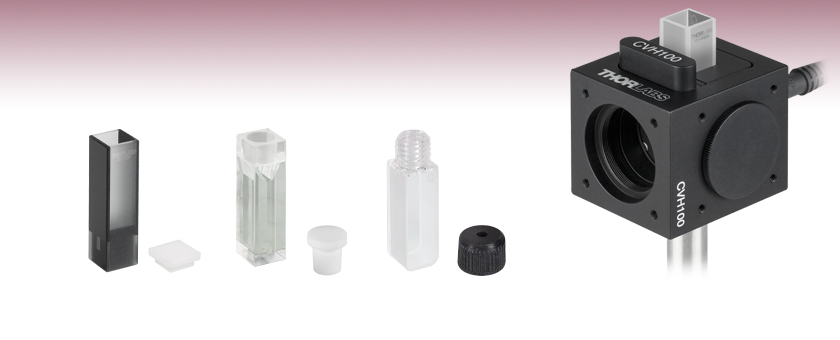
- Optical Synthetic Quartz Glass Cuvettes
- Versions with Two or Four Polished Windows Available
- Super Micro, Micro, and Macro Cuvettes with 100 µL,
700 µL, 1400 µL, or 3500 µL Capacity
CV10Q1
Super Micro
Cuvette,100 µL
CV10Q35EP
Enhanced Chemical
Resistance Macro
Fluorescence Cuvette, 3500 µL
CV10Q7TA
Micro Cuvette,
700 µL
Application Idea
CV10Q35 Cuvette in a CVH100 Cage-Compatible Cuvette Holder

Please Wait
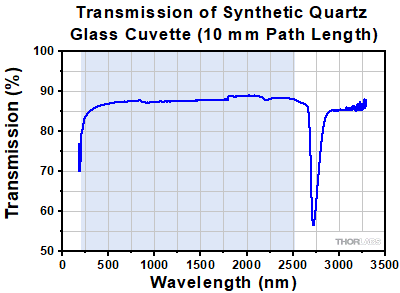
Click to Enlarge
Click for Raw Data
Typical transmission measured through an empty 10 mm cuvette in air. The shaded region indicates the 190 nm to 2.5 µm wavelength range.
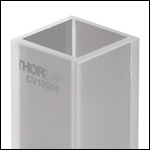
Click to Enlarge
Outer Surfaces of the Cuvettes Feature an Engraved Part Number and a "Q" Indicating their Quartz Construction
Features
- Crafted from Synthetic Quartz Glass for the 190 nm - 2.5 µm Wavelength Range
- Versions with Two or Four Polished Windows for Spectroscopy Applications
- 100 µL, 700 µL, 1400 µL, and 3500 µL Capacities Available
- Standard 12.5 mm Square Profile with 10.00 mm Transmitted Path Length
- Available with PTFE Top Caps, Stoppers, or Septum Screw Caps
Our cuvettes are high-quality cells designed to hold liquid samples. The synthetic quartz glass construction allows these cuvettes to be used with UV light at wavelengths as low as 190 nm, as well as with visible and infrared light up to 2.5 µm. Thorlabs offers cuvettes with either two polished sides, for use in absorption spectroscopy experiments, or four polished sides, for use in fluorescence spectroscopy. The polished sides can be cleaned using standard optics cleaning procedures. Versions are also available with one of three PTFE tops: a cap to block dust and other particles, a stopper to prevent evaporation and provide a seal, or a septum screw cap to provide an airtight seal and prevent contamination until a needle is inserted.
The standard 12.5 mm square outside dimension and 10.00 mm transmitted path length through the sample make these cuvettes compatible with most spectrophotometers as well as our cage-compatible Cuvette Holder, Fiber Optic Filter and Cuvette Mount, and Holder for Integrating Spheres. We offer macro, micro, and super micro sizes (see the tables below for more information), sold in packs of two. The 100 µL cuvettes with four polished sides as well as all 3500 µL cuvettes are also available in a version with enhanced chemical resistance. All cuvettes are engraved on the outer surface with the Item # and a letter "Q" designating synthetic quartz glass construction and the typical input side.
The super micro and micro cuvettes with two polished sides are assembled with glue. Our other cuvettes are assembled by heating the quartz glass to a high temperature and applying pressure to adhere the pieces together. Of these, micro cuvettes that are polished on four sides and all standard macro cuvettes have a quartz glass powder applied to the edges before heating, while the enhanced-chemical-resistance super micro and macro cuvettes are constructed by finely polishing the quartz glass before heating.
Solvent Compatibility
All standard cuvettes should not be used with benzene, toluene, aqua regia, ethanol, corrosive solutions, or other similar substances, as they may degrade the bonds between the pieces and cause the cuvette to leak. The cuvettes with enhanced chemical resistance are compatible with corrosive solutions such as aqua regia. Contact Tech Support for instructions on cleaning the cuvettes found on this page.
For applications that require cuvettes with a enhanced chemical resistance and a shorter optical path length, we offer Enchanced Chemical Resistance Cuvettes with ≤2 mm Path Length. These cuvettes are made from either synthetic quartz glass or borosilicate glass and are available with 350 µL or 700 µL capacity.
| Item # | Min Volume | Length/Width | Path Length | Height | Assembly Process | Material | Wavelength Range |
|---|---|---|---|---|---|---|---|
| Cuvettes with Caps, 2 Polished Sides | |||||||
| CV10Q1 | 100 µL | 12.5 ± 0.2 mm | 10.00 ± 0.08 mm | 45.0 ± 0.3 mm | Gluea | Synthetic Quartz Glass |
190 nm - 2.5 µm |
| CV10Q7 | 700 µL | ||||||
| CV10Q14 | 1400 µL | ||||||
| CV10Q35 | 3500 µL | Fused with Quartz Glass Powderb | |||||
| CV10Q35E | 3500 µL | 12.5 +0.0 / -0.2 mm | 10.00 ± 0.05 mm | Monolithically Co-Firedc | |||
| Cuvettes with Airtight Stoppers, 2 Polished Sides | |||||||
| CV10Q1A | 100 µL | 12.5 ± 0.2 mm | 10.00 ± 0.08 mm | 45.0 ± 0.3 mm | Gluea | Synthetic Quartz Glass |
190 nm - 2.5 µm |
| CV10Q7A | 700 µL | ||||||
| CV10Q14A | 1400 µL | ||||||
| CV10Q35A | 3500 µL | Fused with Quartz Glass Powderb | |||||
| CV10Q35AE | 3500 µL | 12.5 +0.0 / -0.2 mm | 10.00 ± 0.05 mm | Monolithically Co-Firedc | |||
| Cuvettes with Septum Screw Caps, 2 Polished Sides | |||||||
| CV10Q35EP | 3500 µL | 12.5 ± 0.1 mm | 10.00 ± 0.05 mm | 46.0 ± 0.3 mm | Monolithically Co-Firedc | Synthetic Quartz Glass |
190 nm - 2.5 µm |
| Cuvettes with Caps, 4 Polished Sides | |||||||
| CV10Q1FE | 100 µL | 12.5 +0.0 / -0.2 mm | 10.00 ± 0.05 mm | 45.0 ± 0.3 mm | Monolithically Co-Firedc | Synthetic Quartz Glass |
190 nm - 2.5 µm |
| CV10Q7F | 700 µL | 12.5 ± 0.2 mm | 10.00 ± 0.08 mm | Fused with Quartz Glass Powderb | |||
| CV10Q14F | 1400 µL | ||||||
| CV10Q35F | 3500 µL | ||||||
| CV10Q35FE | 3500 µL | 12.5 +0.0 / -0.2 mm | 10.00 ± 0.05 mm | Monolithically Co-Firedc | |||
| Cuvettes with Airtight Stoppers, 4 Polished Sides | |||||||
| CV10Q1FAE | 100 µL | 12.5 +0.0 / -0.2 mm | 10.00 ± 0.05 mm | 45.0 ± 0.3 mm | Monolithically Co-Firedc | Synthetic Quartz Glass |
190 nm - 2.5 µm |
| CV10Q7TAd | 700 µL | 12.5 ± 0.2 mm | 10.00 ± 0.08 mm | Fused with Quartz Glass Powderb | |||
| CV10Q14FA | 1400 µL | ||||||
| CV10Q35FA | 3500 µL | ||||||
| CV10Q35FAE | 3500 µL | 12.5 +0.0 / -0.2 mm | 10.00 ± 0.05 mm | Monolithically Co-Firedc | |||
| Cuvettes with Septum Screw Caps, 4 Polished Sides | |||||||
| CV10Q35FEP | 3500 µL | 12.5 ± 0.1 mm | 10.00 ± 0.05 mm | 46.0 ± 0.3 mm | Monolithically Co-Firedc | Synthetic Quartz Glass |
190 nm - 2.5 µm |
| Posted Comments: | |
user
(posted 2023-03-09 17:08:39.307) You say the cuvettes with enhanced chemical resistance are compatible with corrosive solutions such as aqua regia. Then, can it be used with solvents such as toluene, hexane, ethanol, and acetone?
Also, is the Septum Screw Top provided by CV10Q35FEP washable as in Enhanced Chemical Resistance?
Thank you. cdolbashian
(posted 2023-04-03 02:16:14.0) Thanks for contacting Thorlabs! The cuvettes with enhanced chemical resistance can be used with solvents such as toluene, hexane, ethanol, and acetone. The septum layer of the screw top is made of PTFE, which is also resistant to the solvents you mentioned. The method to clean the septum layer is to use cotton swabs dipped in solutions. Furthermore, We recommend not to fill cuvettes over 90% of their capacity to prevent the septum layer from in contact with the liquid. Daniel Liao
(posted 2022-09-20 22:10:02.653) Hello, I recently received a set of quartz cuvette that come with the air-tight stopper. I tested the quality of the air-tight seal by placing a chunk of fresh shiny lithium metal into the cuvette inside of an argon glovebox. After removing the cuvette with the lithium metal inside into the atmosphere, the lithium slowly oxidized and turned black over 2 hours. This indicates that the air-tight stopper is not providing a sufficient seal in preventing air entering the cuvette and contaminating my sample. Is there a proper way to ensure a good seal? Is there another product that can provide a better seal? I require a quartz cuvette for raman spectroscopy. cdolbashian
(posted 2022-11-08 01:55:16.0) Thank you for your valuable feedback of our products. The commonly used term “airtight” describes cuvettes with a stopper to avoid liquid spills and short-term air seal. However, they don’t guarantee a long-term use while maintaining zero air leakage. We will adjust the web presentation to emphasize the usage of such cuvettes. We also recently released cuvettes with septum screw caps for a more proper air tightening. Ben May
(posted 2020-11-09 05:32:06.803) I ordered CV10Q1400FS and found that both cuvettes included showed massive auto fluorescence which ruined any sample signal. When testing the same sample in different cuvettes the expected signal was produced. YLohia
(posted 2020-11-17 09:51:27.0) Hello, thank you for contacting Thorlabs. We're sorry to hear about the issues you are experiencing with these. We have reached out to you directly to troubleshoot this further. cory.nelson4
(posted 2016-10-04 14:01:33.197) It seems like the transmission is low for a quartz cuvette. Is the transmission in the graph internal transmission or transmission including Fresnel reflection losses? Thanks very much. jlow
(posted 2016-10-14 02:29:23.0) Response from Jeremy at Thorlabs: The transmission graph includes the Fresnel reflection losses from 4 surfaces. e.tirel
(posted 2013-11-25 15:33:34.463) Hi,
This line of product is very attractive, unfortunately the cap that you are using are not good enough for the application I'm looking for.
By using volatile solvent like methanol the square lid are not good enough to stop the evaporation of it.
Also, if one is using oxygen sensitive product a better lid would prevent the oxygen to penetrate the cell for at least a short amount of time.
The lid I'd have liked to see (at least in option) for those cuvette is of this kind: http://www.hellma-analytics.com/kuevetten/135/en/pg_id,40$g_id,28$item_id,114/absorption-cells.html#114
Best
Emmanuel tcohen
(posted 2013-11-26 09:10:32.0) Response from Tim at Thorlabs to Emmanuel: Thank you for your feedback! This would certainly be a valuable addition and we're looking to make this available as an off the shelf solution. |

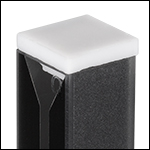
Click to Enlarge
The dust cap rests on top of the cuvette.
- Two Polished Windows for Absorption Spectroscopy
- PTFE Cap Included with Each Cuvette to Block Dust or Other Particles
- Fabricated from Synthetic Quartz Glass (190 nm - 2.5 µm)
- Four Capacities Available: 100 µL, 700 µL, 1400 µL, and 3500 µL
- Cuvette with Enhanced Chemical Resistance Available with a 3500 µL Capacity
- Sold in Packs of 2
These Synthetic Quartz Glass Cuvettes have two polished sides for use in absorption spectroscopy experiments and two frosted sides for handling. For the super micro (100 µL) and micro (700 or 1400 µL) cuvettes, the unused areas of the polished, optical surfaces are blackened to reduce scattered light. The polished sides can be cleaned using standard optics cleaning procedures. Since these cuvettes only have two polished windows, they are not appropriate for use in fluorescence spectroscopy where it is necessary to have four polished windows to allow measurement of the fluorescence at right angles to the beam path. Thorlabs also offers cuvettes with four polished sides below.
These cuvettes have standard 12.5 mm square outer dimensions, a 10.00 mm transmitted path length through the sample, and are available with 100 µL, 700 µL, 1400 µL, or 3500 µL capacities. The 3500 µL cuvettes are available in a standard version (Item # C10Q35) as well as a version with enhanced chemical resistance (Item # C10Q35E). Each cuvette is engraved with the Item # as well as a letter "Q" that designates its synthetic quartz glass construction and the typical input side, and each comes with a PTFE cap to prevent contamination by dust or other particles.
The 100 µL, 700 µL, and 1400 µL cuvettes (Item # CV10Q1, CV10Q7, and CV10Q14, respectively) are assembled with glue, which can be destroyed by benzene or other solutions with strong corrosive characteristics. Both 3500 µL cuvettes are assembled by first heating the quartz glass to a high temperature and then applying pressure to adhere the pieces together, eliminating the need for glue. The standard 3500 µL cuvette (Item # CV10Q35) has quartz glass powder applied to the edges before heating, whereas the 3500 µL cuvette with enhanced chemical resistance is made by finely polishing the quartz glass pieces before attaching, consequently providing smoother seams. This method allows the cuvette with enhanced chemical resistance to hold solutions with corrosive properties, similar to those of nitrohydrochloric acid (aqua regia), without being damaged.
Please note that the standard cuvettes should not be used with benzene, toluene, aqua regia, ethanol, corrosive solutions, or other similar substances, as they may degrade the bonds between the pieces and cause the cuvette to leak.
| Item # | Type | Volume | Length/Width | Path Length | Height | Assembly Process | Material | Wavelength Range |
|---|---|---|---|---|---|---|---|---|
| CV10Q1 | Standard Super Micro | 100 µL | 12.5 ± 0.2 mm | 10.00 ± 0.08 mm | 45.0 ± 0.3 mm | Gluea | Synthetic Quartz Glass |
190 nm - 2.5 µm |
| CV10Q7 | Standard Micro | 700 µL | ||||||
| CV10Q14 | Standard Micro | 1400 µL | ||||||
| CV10Q35 | Standard Macro | 3500 µL | 12.5 ± 0.2 mm | 10.00 ± 0.08 mm | 45.0 ± 0.3 mm | Fused with Quartz Glass Powderb | ||
| CV10Q35E | Enhanced Chemical Resistance Macro |
3500 µL | 12.5 +0.0 / -0.2 mm | 10.00 ± 0.05 mm | 45.0 ± 0.3 mm | Monolithically Co-Firedc |

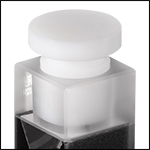
Click to Enlarge
The stopper wedges into the top of the cuvette.
- Two Polished Windows for Absorption Spectroscopy
- PTFE Stopper Included with Each Cuvette
- Fabricated from Synthetic Quartz Glass (190 nm - 2.5 µm)
- Four Capacities Available: 100 µL, 700 µL, 1400 µL, and 3500 µL
- Cuvette with Enhanced Chemical Resistance Available with a 3500 µL Capacity
- Sold in Packs of 2
These Synthetic Quartz Glass Cuvettes have two polished sides for use in absorption spectroscopy experiments and two frosted sides for handling. For the super micro (100 µL) and micro (700 or 1400 µL) cuvettes, the unused areas of the polished, optical surfaces are blackened to reduce scattered light. The polished sides can be cleaned using standard optics cleaning procedures. Since these cuvettes only have two polished windows, they are not appropriate for use in fluorescence spectroscopy where it is necessary to have four polished windows to allow measurement of the fluorescence at right angles to the beam path. Thorlabs offers cuvettes with four polished sides below.
These cuvettes have a standard 12.5 mm square outer dimension, a 10.00 mm transmitted path length through the sample, and are available with 100 µL, 700 µL, 1400 µL, or 3500 µL capacities. The 3500 µL cuvettes are available in a standard version (Item # C10Q35A) as well as a version with enhanced chemical resistance (Item # C10Q35AE). Each cuvette is engraved with the Item # as well as a letter "Q" that designates its synthetic quartz glass construction and the typical input side, and each comes with a PTFE stopper to create a seal and to prevent evaporation and atmospheric contamination of the contents. The stopper should be inserted gently into the top of the cuvette; excessive force will cause difficulty with removing the stopper.
The standard 100 µL, 700 µL, and 1400 µL cuvettes (Item # CV10Q1A, CV10Q7A, and CV10Q14A, respectively) are assembled with glue, which can be destroyed by benzene or other solutions with strong corrosive characteristics. Both 3500 µL cuvettes are assembled by first heating the quartz glass to a high temperature and then applying pressure to adhere the pieces together, eliminating the need for glue. The standard 3500 µL cuvette (Item # CV10Q35A) has quartz glass powder applied to the edges before heating, whereas the 3500 µL cuvette with enhanced chemical resistance is made by finely polishing the quartz glass pieces before attaching, consequently providing smoother seams. This method allows the cuvette with enhanced chemical resistance to hold solutions with corrosive properties, similar to those of nitrohydrochloric acid (aqua regia), without being damaged.
Please note that the standard cuvettes should not be used with benzene, toluene, aqua regia, ethanol, corrosive solutions, or other similar substances, as they may degrade the bonds between the pieces and cause the cuvette to leak.
| Item # | Type | Volume | Length/Width | Path Length | Height | Assembly Process | Material | Wavelength Range |
|---|---|---|---|---|---|---|---|---|
| CV10Q1A | Standard Super Micro | 100 µL | 12.5 ± 0.2 mm | 10.00 ± 0.08 mm | 45.0 ± 0.3 mm | Gluea | Synthetic Quartz Glass |
190 nm - 2.5 µm |
| CV10Q7A | Standard Micro | 700 µL | ||||||
| CV10Q14A | Standard Micro | 1400 µL | ||||||
| CV10Q35A | Standard Macro | 3500 µL | 12.5 ± 0.2 mm | 10.00 ± 0.08 mm | 45.0 ± 0.3 mm | Fused with Quartz Glass Powderb | ||
| CV10Q35AE | Enhanced Chemical Resistance Macro |
3500 µL | 12.5 +0.0 / -0.2 mm | 10.00 ± 0.05 mm | 45.0 ± 0.3 mm | Monolithically Co-Firedc |

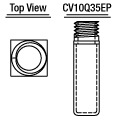
Click to Enlarge
Cuvettes with an engraved "Q" are constructed from synthetic quartz glass.
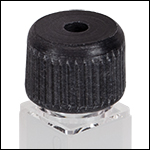
Click to Enlarge
The septum screw top is threaded onto the top of the cuvette.

Click to Enlarge
Cross-Sectional View of the Septum Screw Cap
- Two Polished Windows for Absorption Spectroscopy
- PTFE Septum Screw Cap Included with Each Cuvette
- Red PTFE/ White Silicon Septum
- Fabricated from Synthetic Quartz Glass (190 nm - 2.5 µm)
- Enhanced Chemical Resistance Cuvette with a 3500 µL Capacity
- Sold in Packs of 2
This Synthetic Quartz Glass Cuvette has two polished sides for use in absorption spectroscopy experiments and two frosted sides for handling. The polished sides can be cleaned using standard optics cleaning procedures. Since this cuvette only has two polished windows, they are not appropriate for use in fluorescence spectroscopy where it is necessary to have four polished windows to allow measurement of the fluorescence at right angles to the beam path. Thorlabs offers cuvettes with four polished sides below.
This cuvette, which has enhanced chemical resistance, has a 3500 µL capacity, a standard 12.5 mm square outer dimension, and a 10.00 mm transmitted path length through the sample. Each cuvette is engraved with the Item # as well as a letter "Q" that designates its synthetic quartz glass construction and the typical input side.
A PTFE septum screw cap is included with each cuvette, which creates an airtight seal to prevent evaporation and atmospheric contamination of the contents. The cap includes a red PTFE/ white silicon septum with a 50 °shore hardness, which provides provide a leakproof seal until a needle is pierced through the top.
Designed for enhanced chemical resistance, this cuvette is assembled by first heating the quartz glass to a high temperature and then applying pressure to adhere the pieces together, eliminating the need for glue. The quartz glass pieces are finely polished before attaching, consequently providing smoother seams. This method allows the cuvette to hold solutions with corrosive properties, similar to those of nitrohydrochloric acid (aqua regia), without being damaged.
| Item # | Type | Volume | Length/Width | Path Length | Height | Assembly Process | Material | Wavelength Range |
|---|---|---|---|---|---|---|---|---|
| CV10Q35EP | Enhanced Chemical Resistance Macro |
3500 µL | 12.5 mm ± 0.1 mm | 10.00 mm ± 0.05 mm | 46.0 mm ± 0.3 mm | Monolithically Co-Fireda | Synthetic Quartz Glass |
190 nm - 2.5 µm |

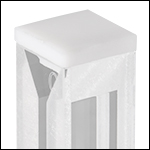
Click to Enlarge
The dust cap rests on top of the cuvette.
- Four Polished Windows for Fluorescence Spectroscopy
- PTFE Cap Included with Each Cuvette to Block Dust or Other Particles
- Fabricated from Synthetic Quartz Glass (190 nm - 2.5 µm)
- Four Capacities Available: 100 µL, 700 µL, 1400 µL, and 3500 µL
- Cuvettes with Enhanced Chemical Resistance Available with a 100 µL or 3500 µL Capacity
- Sold in Packs of 2
These Synthetic Quartz Glass Cuvettes have four polished sides for use in fluorescence spectroscopy experiments. The four polished windows allow measurement of the fluorescence at right angles to the beam path and can be cleaned using standard optics cleaning procedures. While these cuvettes are designed for use in fluorescence, the through beam windows can be used independently for other spectroscopic applications. Thorlabs also offers cuvettes with two polished sides and two frosted sides designed specifically for these other applications (sold above).
These cuvettes have a standard 12.5 mm square outer dimension, a 10.00 mm transmitted path length through the sample, and are available with 100 µL, 700 µL, 1400 µL, or 3500 µL capacities. Each cuvette is engraved with the Item # as well as a letter "Q" that designates its synthetic quartz glass construction and the optical window axis, and each comes with a PTFE cap to prevent contamination by dust or other particles.
The cuvettes are assembled by first heating the quartz glass to a high temperature and then applying pressure to adhere the pieces together, eliminating the need for glue. For the standard 700 µL, 1400 µL, and 3500 µL cuvettes (Item # CV10Q7F CV10Q14F, and CV10Q35F, respectively), quartz glass powder is applied to the edges of the pieces prior to heating. For the cuvettes with enhanced chemical resistance, available in 100 µL or 3500 µL capacities, the quartz glass pieces are finely polished before attaching, consequently providing smoother seams. This method allows the enhanced-chemical-resistance cuvettes to hold solutions with corrosive properties, similar to those of nitrohydrochloric acid (aqua regia), without being damaged.
Note that all standard cuvettes should not be used with benzene, toluene, aqua regia, ethanol, corrosive solutions, or other similar substances, as they may degrade the bonds between the pieces and cause the cuvette to leak.
| Item # | Type | Volume | Length/Width | Path Length | Height | Assembly Process | Material | Wavelength Range |
|---|---|---|---|---|---|---|---|---|
| CV10Q1FE | Enhanced Chemical Resistance Super Micro |
100 µL | 12.5 +0.0 / -0.2 mm | 10.00 ± 0.05 mm | 45.0 ± 0.3 mm | Monolithically Co-Fireda | Synthetic Quartz Glass |
190 nm - 2.5 µm |
| CV10Q7F | Standard Micro | 700 µL | 12.5 ± 0.2 mm | 10.00 ± 0.08 mm | 45.0 ± 0.3 mm | Fused with Quartz Glass Powderb | ||
| CV10Q14F | Standard Micro | 1400 µL | ||||||
| CV10Q35F | Standard Macro | 3500 µL | ||||||
| CV10Q35FE | Enhanced Chemical Resistance Macro |
3500 µL | 12.5 +0.0 / -0.2 mm | 10.00 ± 0.05 mm | 45.0 ± 0.3 mm | Monolithically Co-Fireda |

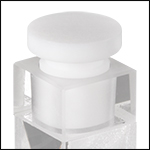
Click to Enlarge
The stopper wedges into the top of the cuvette.
- Four Polished Windows for Fluorescence Spectroscopy
- PTFE Stopper Included with Each Cuvette
- Fabricated from Synthetic Quartz Glass (190 nm - 2.5 µm)
- Four Capacities Available: 100 µL, 700 µL, 1400 µL, and 3500 µL
- Cuvettes with Enhanced Chemical Resistance Available with a 100 µL or 3500 µL Capacity
- Sold in Packs of 2
These Synthetic Quartz Glass Cuvettes have four polished sides for use in fluorescence spectroscopy experiments. The four polished windows allow measurement of the fluorescence at right angles to the beam path and can be cleaned using standard optics cleaning procedures. While these cuvettes are designed for use in fluorescence, the through beam windows can be used independently for other spectroscopic applications. Thorlabs also offers cuvettes with two polished sides and two frosted sides designed specifically for these other applications (sold above).
These cuvettes have a standard 12.5 mm square outer dimension, a 10.00 mm transmitted path length through the sample, and are available with 100 µL, 700 µL, 1400 µL, or 3500 µL capacities. Each cuvette is engraved with the Item # as well as a letter "Q" that designates its synthetic quartz glass construction and the optical window axis, and each comes with a PTFE stopper to create a seal and to prevent evaporation and atmospheric contamination of the contents. The stopper should be inserted gently into the top of the cuvette; excessive force will cause difficulty with removing the stopper.
The cuvettes are assembled by first heating the quartz glass to a high temperature and then applying pressure to adhere the pieces together, eliminating the need for glue. For the standard 700 µL, 1400 µL, and 3500 µL cuvettes (Item #'s CV10Q7TA, CV10Q14FA, and CV10Q35FA, respectively), quartz glass powder is applied to the edges of the pieces prior to heating.
We also offer enhanced, chemically resistant cuvettes in capacities of 100 µL and 3500 µL. Both types of cuvettes are assembled by first heating the quartz glass to a high temperature and then applying pressure to adhere the pieces together, eliminating the need for glue. For the cuvettes with enhanced chemical resistance, available in 100 µL and 3500 µL capcities, the quartz glass pieces are finely polished before attaching, consequently providing smoother seams. This method allows the cuvettes with enhanced chemical resistance to hold solutions with corrosive properties, similar to those of nitrohydrochloric acid (aqua regia), without being damaged.
Please note that the standard cuvettes should not be used with benzene, toluene, aqua regia, ethanol, corrosive solutions, or other similar substances, as they may degrade the bonds between the pieces and cause the cuvette to leak.
| Item # | Type | Volume | Length/Width | Path Length | Height | Assembly Process | Material | Wavelength Range |
|---|---|---|---|---|---|---|---|---|
| CV10Q1FAE | Enhanced Chemical Resistance Super Micro |
100 µL | 12.5 +0.0 / -0.2 mm | 10.00 ± 0.05 mm | 45.0 ± 0.3 mm | Monolithically Co-Firedb | Synthetic Quartz Glass |
190 nm - 2.5 µm |
| CV10Q7TAa | Standard Micro | 700 µL | 12.5 ± 0.2 mm | 10.00 ± 0.08 mm | 45.0 ± 0.3 mm | Fused with Quartz Glass Powderc | ||
| CV10Q14FA | Standard Micro | 1400 µL | ||||||
| CV10Q35FA | Standard Macro | 3500 µL | ||||||
| CV10Q35FAE | Enhanced Chemical Resistance Macro |
3500 µL | 12.5 +0.0 / -0.2 mm | 10.00 ± 0.05 mm | 45.0 ± 0.3 mm | Monolithically Co-Firedb |

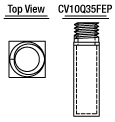
Click to Enlarge
Cuvettes with an engraved "Q" are constructed from synthetic quartz glass.
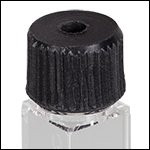
Click to Enlarge
The septum screw top is threaded onto the top of the cuvette.

Click to Enlarge
Cross-Sectional View of the Septum Screw Cap
- Four Polished Windows for Fluorescence Spectroscopy
- PTFE Septum Screw Cap Included with Each Cuvette
- Red PTFE/ White Silicon Septum
- Fabricated from Synthetic Quartz Glass (190 nm - 2.5 µm)
- Enhanced Chemical Resistance Cuvette with a 3500 µL Capacity
- Sold in Packs of 2
This Synthetic Quartz Glass Cuvette has four polished sides for use in fluorescence spectroscopy experiments. The four polished windows allow measurement of the fluorescence at right angles to the beam path and can be cleaned using standard optics cleaning procedures. While this cuvette is designed for use in fluorescence, the through beam windows can be used independently for other spectroscopic applications. Thorlabs also offers cuvettes with two polished sides and two frosted sides designed specifically for these other applications (sold above).
This cuvette, which has enhanced chemical resistance, has a 3500 µL capacity, a standard 12.5 mm square outer dimension, and a 10.00 mm transmitted path length through the sample. Each cuvette is engraved with the Item # as well as a letter "Q" that designates its synthetic quartz glass construction and the typical input side.
A PTFE septum screw cap is included with each cuvette, which creates an airtight seal to prevent evaporation and atmospheric contamination of the contents. The cap includes a red PTFE/ white silicon septum with a 50 °shore hardness, which provides provide a leakproof seal until a needle is pierced through the top.
Designed for enhanced chemical resistance, this cuvette is assembled by first heating the quartz glass to a high temperature and then applying pressure to adhere the pieces together, eliminating the need for glue. The quartz glass pieces are finely polished before attaching, consequently providing smoother seams. This method allows the cuvette to hold solutions with corrosive properties, similar to those of nitrohydrochloric acid (aqua regia), without being damaged.
| Item # | Type | Volume | Length/Width | Path Length | Height | Assembly Process | Material | Wavelength Range |
|---|---|---|---|---|---|---|---|---|
| CV10Q35FEP | Enhanced Chemical Resistance Macro |
3500 µL | 12.5 mm ± 0.1 mm | 10.00 mm ± 0.05 mm | 46.0 mm ± 0.3 mm | Monolithically Co-Fireda | Synthetic Quartz Glass |
190 nm - 2.5 µm |
 Products Home
Products Home


















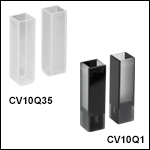
 Zoom
Zoom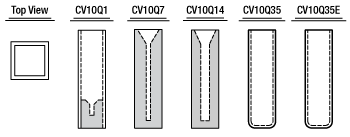
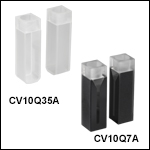
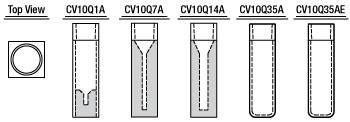
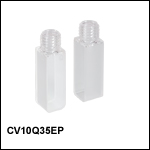
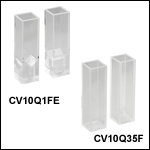
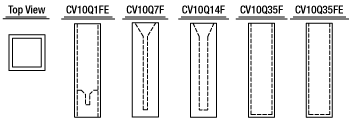

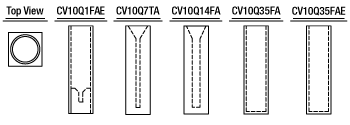
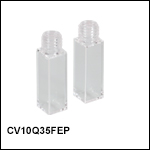
 Cuvettes, 10 mm Path Length
Cuvettes, 10 mm Path Length